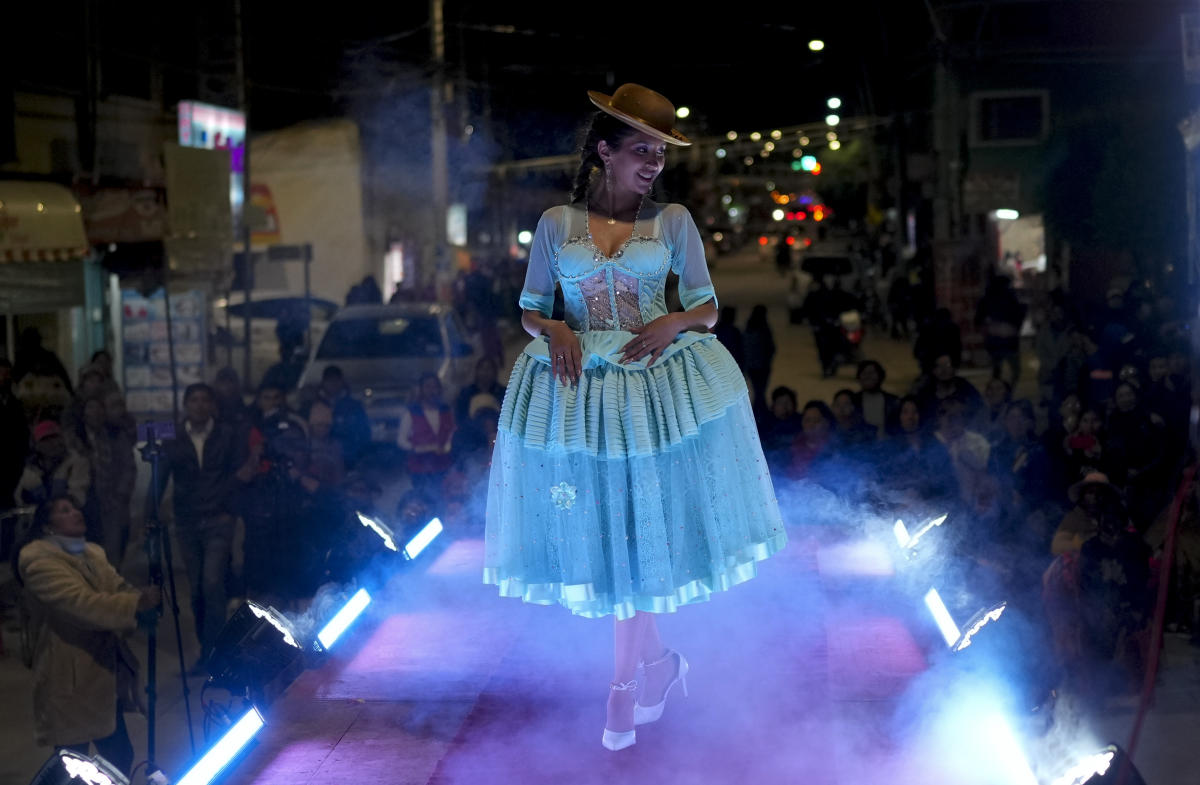VIACHA, Bolivia (AP) — In the densely packed markets, sprawling farms and vibrant parties of Viacha, a city southeast of Bolivia’s capital, women typically wear bowler hats, tiered skirts and fringed scarves.
What is less typical is that fashion attention focuses on these outfits – worn by ‘Cholas’, indigenous women from the highland Altiplano.
But late Friday in Viacha, some 14 miles from the Bolivian capital La Paz – more than 12,000 feet (3,650 meters) above sea level – awestruck teenage boys and proud mothers pounded the main square as the town’s dirt road was briefly closed. converted into a runway.
Trusted news and daily treats, straight to your inbox
See for yourself: The Yodel is the source for daily news, entertainment and feel-good stories.
One by one, the Viacha girls – mostly students between the ages of 15 and 25 – paraded across the catwalk to a surprising soundtrack of American pop music from the early 2000s. Street vendors sold hot dogs and empanadas. Supporters cheered in Spanish and the indigenous Aymaran language.
Wearing glittering shoes and brightly colored stand-up skirts called ‘polleras’, the amateur models of all heights and sizes twirled around, tipped their hats and cast sultry glances at the crowd.
“Years ago, people associated these skirts with the fields, they looked down on us as farmers in the countryside,” said Rogelia Canaviri, 42, who couldn’t stop smiling as she watched her daughter Carolina walk down the runway. dangling pearl earrings, the sequins on her tiered red skirt catching the stage lights.
“It is something I am proud of, to see my daughter and her friends enjoying what I have worn for work all my life,” she said, pointing to the wool scarf, velvet hat and calm beige pollera she wore – the same clothes, she said, that she still wears to milk her cows and sell her cheese at open-air markets. Her own mother did the same.
Generations ago, the Aymara were subjected to waves of conquest and dispossession, first by the Inca, then by the Spanish, who forced the indigenous communities to abandon their traditional way of dressing and adopt the style then popular at the court of Seville.
Legend has it that the cheerful felt bowler hat became a crucial part of fashion after it was introduced by British railway workers in the 1920s.
Bolivia’s whiter, more affluent population has used “Chola” – and its diminutive “Cholita” – as dismissive racial epithets. But in recent decades that stigma has disappeared, with indigenous Aymara proudly reclaiming the word and younger Bolivians rediscovering the charm of the vibrant clothing of their mothers and grandmothers.
“I think the ‘Cholita’ has become something very interesting and exciting in our current context,” says Brittany Cantuta Valeria, 21, a first-time model, her hat with the brim up and her cheeks flushed reddish gold.
“We are now on the cusp of being respected because of everything that has been implemented, so I wear this to have fun, to show off, to go to parties and dances. I have nothing to do with working the fields.”
Most of the girls who paraded on stage Friday during the show organized by the municipality of Viacha grew up during the term of former left-wing President Evo Morales (2006-2019), the country’s first-ever indigenous president whose championed the indigenous majority of Bolivia earned him fervent support for the concrete block and mud houses of the Altiplano.
Morales established a new constitution, which, among other things, increased the recognition of Bolivia’s 36 ethnic groups. He promoted education in indigenous languages and encouraged state funding for folk arts. Chola catwalk shows and beauty pageants increased, expanding the reach of Bolivia’s indigenous highland culture.
But the fashion fanfare was largely confined to La Paz, the seat of government. Before Friday, the town of Viacha, like most other villages across these austere mountain plains, had never hit the airstrip.
“I was very nervous, but I realized this is the first time for all of us,” said 15-year-old Tomasa Ramirez. ‘I feel so beautiful. Now I know my dream is to be a Cholita model.”
As Bolivia’s economic crisis closes in like a vice on families whose money has lost value while the cost of food has doubled, many girls say it’s not easy to walk the show.
Premium velvet hats and scarves made from vicuña wool with silk fringes can fetch thousands of dollars. Polleras cost a few hundred dollars. Then there’s the jewelry – ideally made of real gold, pearls and diamonds when worn to these types of formal events.
“There was no way I could get real earrings this year,” says 16-year-old Julieta Mamani, pointing to her gold-colored earrings. “I hope next year will be different.”
Canaviri, the dairy farmer, sees her 24-year-old daughter posing for selfies in her elaborate skirt and still has a hope.
“I hope she doesn’t like wearing pants,” she said of her daughter. “I tried on pants once in my life and I felt naked. Never again.”

